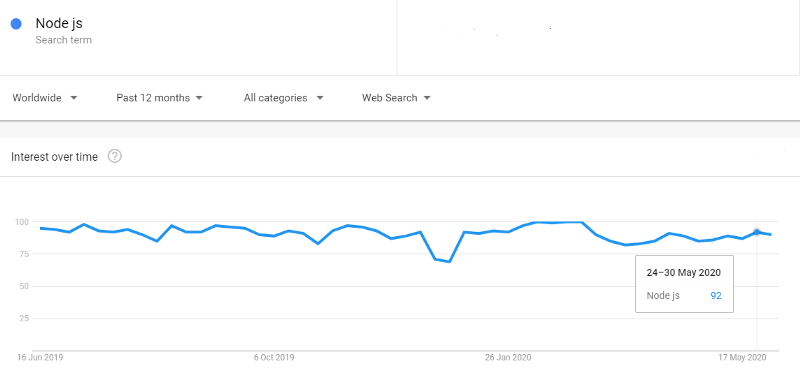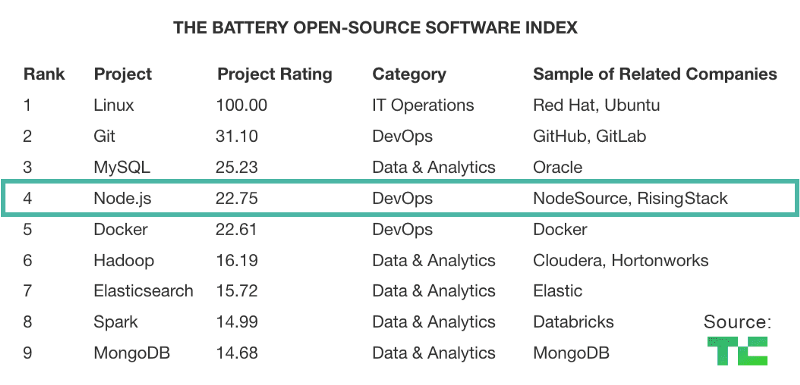
Do you know Node.js has turned 11 on 27th May 2020? Can’t believe we have stepped into a new decade of this technology? Okay! Let me tell you the truth and story behind it with this article.
JavaScript has come a long way with its constant bombardment of open-source frameworks. We all have embraced its journey, and Node.js is one of its prevalent and predominant innovations that knocked this tech arena on May 27th, 2009. So, technically and mathematically, both Node.js is 11 years old now.
Today, its role and importance is not an introductory factor to any of us. If we look at the stats, then still 8 out of 10 developers are utilizing this cross-development platform.

Source: Google Trends
Node JS, the platform built on Chrome’s JavaScript, is an open-source cross-development platform. It aids in the,e development of fast and scalable network applications — additionally, its lightweight, efficient, and perfect for data-intensive real-time applications that run across distributed devices.
In the web development world, high performing sites are the absolute need of the users today, and here Node js has some significant perks to offer. Know these once:
Node JS Benefits
- Easy scalability
- Easy to learn
- Used as a single programming language
- Full-stack javascript
- Offers high performance
- Support of large and active community
- Mobile app development freedom
- Support for commonly used tools
The History of Node.JS

In 2009, Ryan Dahl wrote Node JS initially, and it’s exactly about thirteen years after the first server-side JavaScript environment, Netscape’s LiveWire Pro Web introduced. The initial release was supported only on Linux and Mac OS X. Its development and maintenance part was under Dahl’s control, and later the sponsorship passed to Joyent.
Netscape LiveWire was developed to create dynamic pages with server-side JavaScript. Unfortunately, it was not proved successful and led to the rise of the next JavaScript framework, i.e. Node JS. It had great timing as just a few years earlier JavaScript gained the major highlight as a more serious language. Thanks to “Web 2.0” applications such as Flickr, Gmail, etc. that showed a vital glimpse of the next world and modern experience.
JavaScript engine also gained a significant highlight with Node JS to offer users the best performance as compared to others. Developers worked hard to provide better support for JavaScript and make it faster. Even the engine that it uses under the hood V8 (also called Chrome V8) improved significantly to occupy a significant edge in the market.
Therefore, it’s worth saying that Node.js has brought to the market at the right time, but its luck doesn’t create its fortune in the market. It has introduced lots of innovative approaches for JavaScript server-side to aid the developer’s community and became the preferred choice of each and every Node.js development company in India.
Now, let’s back into the history of Node.js on a timeline, from 2009 until now 2020
Node.JS in 2009
- Node.js was released on 27th May
- Shared the first preview of npm, the Node package manager
- Ryan Dahl had shown the first presentation of Node js
Node.JS in 2010
- Express: A Node.js web development framework launched
- The initial release of Socket.io
- Experimental Node.js Support on Heroku
- Ryan Dahl’s Google Tech Talk
- Node.js 0.2.0 released
Node.JS in 2011
- Node.js Guide
- Ryan Dahl’s AMA on Reddit
- npm 1.0 launched
- LinkedIn started using Node JS and launched its fully overhauled mobile app with new features and parts under the hood.
- Ryan Dahl shares the history of Node.js and his motive behind its development.
- Uber also followed the path of Linkedin and used Node js re-engineer their application. The company also explained the reason behind its extension to Node JS that was to increase efficiency and improve partner and customer experience.
Node.JS in 2012
- The stable version of Node.js v0.8.0 is out
- Hapi, a Node.js framework
Node.JS in 2013
- Ghost: Blogging with Node.js
- Ghost is an open-source publishing platform. It is beautifully designed, easy to use, and free for everyone.
- The MEAN Stack: MongoDB, ExpressJS, AngularJS, and Node.js
- PayPal introduced Kraken, a Node.js framework
- Koa — a new web framework for Node.js launched
Node.JS in 2014
- NodeJS major fork io.js, with the motive of introducing ES6 support and moving faster
Node.JS in 2015
- The Node.js Foundation introduced
- IO.js got merged back into Node.js
- npm introduces private modules
- Node.js 4 was released
Node.JS in 2016
- Incident of leftpad
- Yarn was introduced
- Node.js 6
Node.JS in 2017- The year of mainstream adoption
2017 was an important year in the history of Node JS and its users. Its online instances reached 8.8 million, with 3 billion npm package downloads a week.

Source: RisingStack
The contributor’s count grew to 1500, and Node rated with more than 40,000 stars on GitHub.
According to The Battery Ventures Open Source Software Index, Node was the 4th most crucial open-source project in the year 2017.

- Node 8 launched with new advanced features
- npm concentrated more on security
- HTTP2 arrived into the Node.js Core
- V8 introduced Node.js in its testing suite for performance improvement.
- npm downloads reached 3 billion every week
Node.JS in 2018
- Node.js Project introduces the latest Release line, and it was Node.js 10.x
- A new plan of ECMAScript modules in Node.js
Node.JS in 2019

Source: Medium
- Node.js Foundation and the JS Foundation merged to form the OpenJS Foundation.
- Announced the new experimental modules
- Node JS 12 released and following are its significant highlights
- V8 updated to version 7.4
- Async stack traces came
- New JavaScript language features
- Faster async/await implementation
- Performance tweaks & improvements
- Improvement on Worker threads, N-API
- Default HTTP parser switched to llhttp
- New experimental “Diagnostic Reports” feature
Node.JS in 2020
- Node. js version 13.x ended recently on June 1st
- The supported versions of Node JS 10.x, 12.x, and 14.x are vulnerable
- The latest release 14.x launched on April 21st
- And the future release of 15.x is scheduled for October 21st
Wrapping Up
How’s your Node.JS journey from 2009 to 2020? I hope now you have a better understanding of its importance and advancement? I guess Yes. Node JS has achieved a milestone in its 11 years and expecting some more advancements in the coming year and one is also in the queue.
Let me know your queries and feedbacks in the comment section or if you want to leverage its perks then contact a node.js development company. They will aid you best and suggest its potential business benefits.
And now last but not least:
Happy 11 Years of Node.JS and Wishing More Advancements In The Coming Years